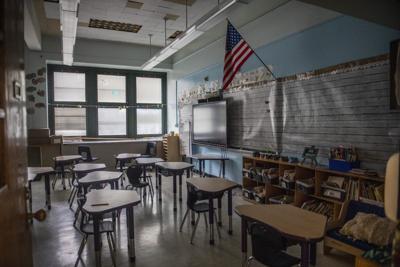
(AP Photo/Brittainy Newman, File)
This story was originally published by EdSource. Sign up for their daily newsletter.
Top Takeaways
- The Trump administration adds a $100,000 fee to H-1B work visas, impacting California’s tech industry and schools.
- California employs more teachers on H-1B visas than any state except Texas and North Carolina.
- School districts are already struggling with finances because of declining enrollment, and can’t afford the $100,000 charge.
A White House decision to add $100,000 to the price of a work visa, allowing employers to hire from overseas for hard-to-fill positions, has California’s technology industry and other businesses reeling. But another group is also on edge: the state’s schools.
California employs more teachers on H-1B visas than any state except Texas and North Carolina, according to a National Education Association analysis of federal data. Last fiscal year, 506 U.S. school districts employed 2,300 H-1B visa holders.
The demand for the visas from California school districts has grown over the last seven years as the state’s schools, facing teacher shortages, have turned to overseas teachers to help fill openings.
Last school year, 294 H-1B visas were granted to the state’s school districts, compared to 193 in 2018-19, according to the California Department of Education. The visas are typically good for three years with a possible three-year extension.
But the new $100,000 charge for the H-1B visa is beyond what most districts can afford.
“For these small, resource-limited districts, a $100,000 fee would be entirely cost-prohibitive and would effectively close off one of the few pipelines for qualified teachers,” said Yuri Calderon, executive director of the Small School Districts’ Association.
Until Sept. 21, school districts and other employers paid application and processing fees of about $3,700 for the visa, depending on their size. But that was before President Donald Trump issued a proclamation adding the $100,000 fee, effective two days later.
The increase is meant to prevent the replacement of American workers with lower-paid workers from overseas, according to the proclamation.
Although the fee increase may not immediately impact school districts, because it will not be levied on renewals or extensions of existing H-1B visas, it will have repercussions in a few months when school leaders begin to hire for the next school year.
Rural districts could take a hit
The $100,000 fee could be especially devastating to small school districts already facing severe teacher shortages, Calderon said.
“Rural and geographically isolated communities are increasingly dependent on international, fully credentialed teachers to fill positions that have proven nearly impossible to staff,” Calderon said. “This is particularly true in the case of middle and high school math, science and special education.”
More underprepared teachers
The Vallejo City Unified School District has more than 20 teachers working on H-1B visas this school year, said Hattie Kogami, director of human resources at Vallejo City Unified. The district was granted 12 more visas last school year.
District leaders had planned to hire 15 additional teachers from the Philippines on H-1B visas for the coming year, but only managed to hire nine before the new fee was levied.
“Our district is in declining enrollment, and so we’re dealing with the real struggles of cutting $40 million,” Kogami said. “So, we definitely don’t have a hundred thousand dollars to bring in these six people or anyone else for that matter.”
That means the district, with a student population that is more than a quarter English learners, will probably have to hire more underprepared teachers. The district already hires between 20 and 30 teachers without the appropriate teaching credentials each year, Kogami said.
“We always have a ton of non-credentialed teachers,” Kogami said. “That’s why we started wanting to use the H-1B. Those people have been through a program; they know what to do.”
In 2022, an EdSource analysis found that nearly 1 out of 5 classes in California were taught by underprepared teachers working on emergency-style permits because of a shortage of credentialed teachers. Many of the shortages were in special education, math, science and foreign language classrooms.
Teachers with H-1B visas who have been credentialed in other countries have at least a bachelor’s degree and have completed teacher preparation programs. Their college transcripts, certificates and licenses are evaluated by an agency approved by the California Commission on Teacher Credentialing before they are issued a preliminary teaching credential.
Like all California teachers, they have to prove subject-matter competency, complete a CPR course and a U.S. Constitution course, and finish a two-year individualized program of mentoring and support called teacher induction.
The United States government limits the number of H-1B visas to 65,000 a year, with an additional 20,000 going to people with master’s or doctoral degrees. There have historically been more applicants than available visas, so the applicants are selected through a computerized lottery system.
School leaders want an exemption
The Trump administration has already made changes to the $100,000 fee requirement, updating the U.S. Citizen and Immigration Services website last week to clarify that the fee would not apply to people already in the U.S. under other visas who want to move to an H-1B visa.
Education leaders are hopeful that the Trump administration will go a step further and exempt schools entirely from the fee.
“Without such an exemption, this change could have a devastating impact on small school districts already facing severe teacher shortages,” Calderon said.
Relief could also come from lawsuits challenging the fee filed this month, including one by the U.S. Chamber of Commerce and another by a coalition of unions, employers and religious groups.
J-1 visa offers short-term option
The J-1 visa, also called an exchange visitor visa, is an option for school districts in need of teachers, but it has more stringent requirements that make it a difficult fit for low-performing school districts, Kogami said. She prefers H-1B visas because they can lead to a green card and permanent residency, which often means a long-term employee.
“We’re going to try to move all of our folks that we’ve hired that stay with us to green card status,” Kogami said.
Evelyn Anderson, principal of the Santa Rosa French-American Charter School, likes the J-1 visa because it doesn’t use a lottery system to allocate the visas, and although the teacher candidate must be interviewed at the U.S. Embassy in their home country, they are seldom denied.
But she started helping some of her teachers move to H-1B visas to extend their stays after having difficulty finding teachers during Trump’s first term and during the Covid pandemic.
The Santa Rosa City Schools charter school is one of more than 50 similar schools in the U.S. that are accredited by the French Ministry of Education. One of the requirements is that all its teachers have French teaching credentials, which means most are from France or French-speaking countries.
Although the $100,000 fee for the H-1B visa isn’t impacting the Santa Rosa French-American Charter School directly, because school leaders haven’t hired teachers from overseas on the H-1B visa, Anderson, the principal, still has her concerns.
“When I do have to recruit the new teachers to come on a J-1, will they be hesitant because there is this overall feeling that the U.S. isn’t as welcoming?” she wondered.
Daniel Willis contributed to this report.











(0) comments
Welcome to the discussion.
Log In
Keep it Clean. Please avoid obscene, vulgar, lewd, racist or sexually-oriented language.
PLEASE TURN OFF YOUR CAPS LOCK.
Don't Threaten. Threats of harming another person will not be tolerated.
Be Truthful. Don't knowingly lie about anyone or anything.
Be Nice. No racism, sexism or any sort of -ism that is degrading to another person.
Be Proactive. Use the 'Report' link on each comment to let us know of abusive posts.
Share with Us. We'd love to hear eyewitness accounts, the history behind an article.